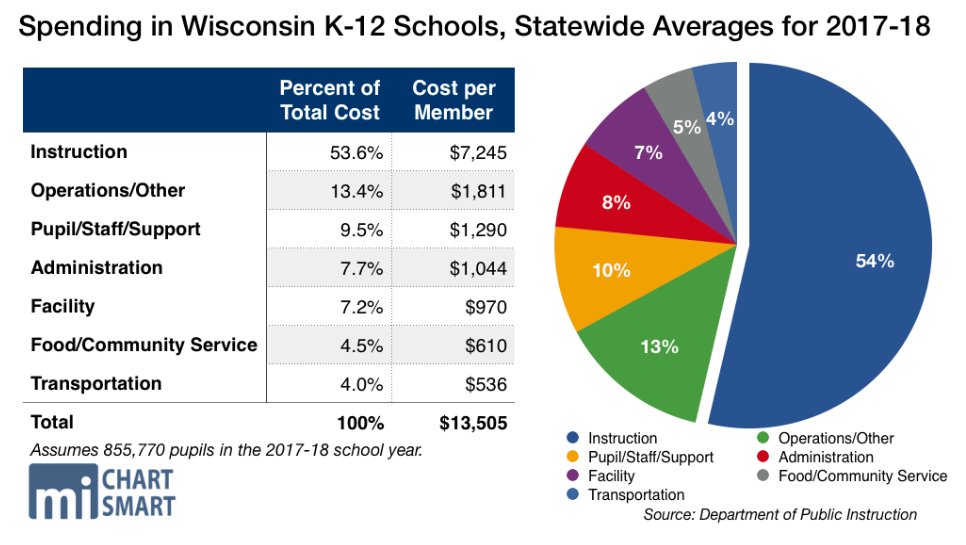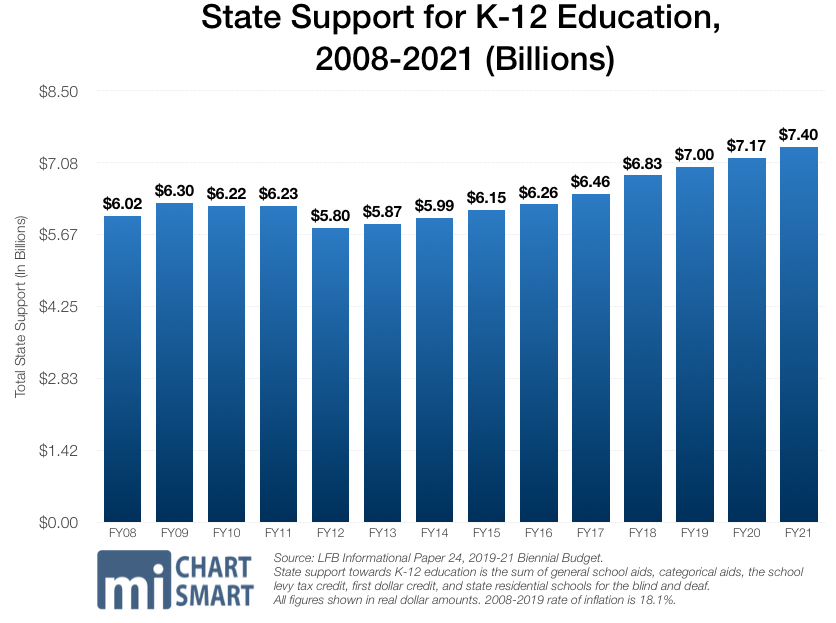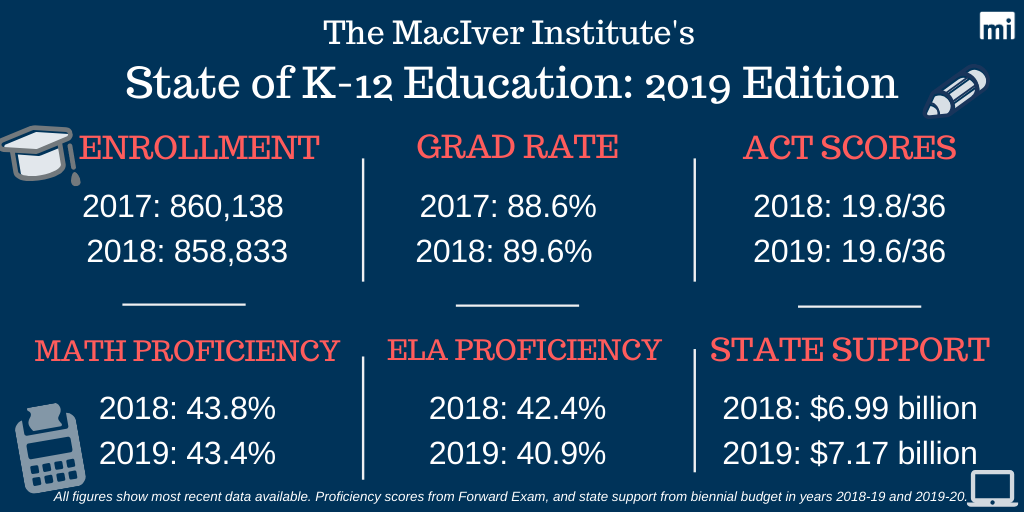
The last two state budgets significantly increased K-12 funding, but the proportion spent in classrooms has slightly dipped
January 28, 2020
By Ola Lisowski
Data from the Department of Public Instruction (DPI) show that just 53.6 percent of K-12 spending goes toward classroom instruction. Despite record-high increases to education funding, the percentage of dollars reaching the classroom has fallen slightly compared to the prior year.

The figures come from the 2017-18 school year, the most recent numbers available. For fiscal year 2018, school districts spent an average of $13,505 per student. That’s a $323 increase from 2017, when districts statewide spent an average of $13,182 for each student.
The dataset reflects funding levels during former Gov. Scott Walker’s final state budget, for the 2017-19 biennium. That budget increased total K-12 spending by more than $630 million over prior levels. Current Gov. Tony Evers’ 2019-2021 budget, passed last summer, increased K-12 spending by another $655 million. All told, the most recent budget will send $14 billion to K-12 schools.
Taxpayers are likely surprised to learn that just a slim majority of K-12 funds are spent on instruction. An average of $7,245 goes toward the classroom instruction of each student. The largest portion of instruction costs is the salaries and benefits of teachers.
Even as state taxpayers have recently poured billions more into K12 education, the percentage of dollars reaching the classroom is still 54%
Schools have taken on numerous roles outside of the instruction of students, and the budget allocations reflect that reality. If top-heavy overhead were reduced, perhaps the teachers doing the vast majority of meaningful work in schools could be better compensated.
The second-highest category of spending is on “operations/other,” a catch-all category that captures 13.4 percent of spending, or $1,811 per student. That category includes items such as central services, maintenance, debt service, insurance, and post-employment benefit debt.
Pupil/staff/support took 9.5 percent of overall spending for approximately $1,290 per student. Expenditures including guidance counselors, school nurses, and professional development support for staff fall into that category.
Administrative costs took 7.7 percent for an average of $1,044 per student. School business costs, administrative assistants, building and grounds departments, and other similar line items are included in the administrative category.
While the percentages were not significantly different from the prior year’s allocations, the largest percent change was to instruction, where spending fell slightly.
As school spending continues to increase, taxpayers must be aware of the extent to which new money actually reaches students. Even as spending increased overall, the percentage of dollars targeted at classroom instruction dipped.
Districts that spend more overall don’t necessarily spend more on student instruction. Geneva spends just 27% of its $20,205 per-student cost on instruction, while Sevastopol spends 67% of its $15,299 per student on instruction.
District spending breakdowns vary widely across the state, but one thing is clear: total dollars spent on each student does not correlate with total dollars spent on instruction. Consider the difference between Geneva J4 and Sevastopol, which spend the least and the most, respectively, on instruction.
Among all districts, Geneva J4 spends the lowest percentage on instruction, with just 27 percent of total spending going into classrooms. The district spends $5,511 on instruction and $5,785 on facilities for each of its 120 students. Total spending per student at Geneva J4 is $20,205.
Sevastopol spends the largest percentage of its funding on instruction, at 67 percent of spending going into classrooms. The district spends $15,299 per student, and $10,312 goes to instruction.
North Lakeland spends the most per student overall, at $29,464 total. Less than half, 45 percent, of the funding goes to classroom instruction. Medford Area spends the least overall amount of money per student, at $10,934 for each pupil. Fifty percent of the spending goes to instruction.
In 2017, Grantsburg spent the smallest percentage on instruction, at 29 percent. In this 2018 dataset, the district improved its share of instruction spending slightly, moving to 31 percent of all spending, the third-lowest amount of any district. Still, the district again spent the most on its administration, at 23 percent overall.

The data report shows that at 52 percent of spending, Milwaukee Public Schools (MPS) spent slightly less than the state average on instruction as a percentage of total spending. Overall, the district spent more than the state average on each student, at $15,250 for each of its 77,154 students.
As a percentage of total spending, MPS spends less than the state average on its facilities (3 percent compared to 7 percent) but more on pupil/staff/support (12 percent compared to 10 percent) and food/community service (7 percent compared to 5 percent).
The MPS school board recently approved a referendum for inclusion in the coming April election. The district will ask taxpayers to spend $87 million over current levels.
Even as total funding increases, dollars reaching the classroom have remained nearly stagnant. So, too, has student achievement: just four out of ten Wisconsin students are proficient in math or English.
Wisconsin politicians on both sides of the aisle have repeatedly voted to increase education funding by hundreds of millions of dollars. Now, the public should ask for their plans to ensure that funding actually reaches the classroom, where it might have a chance at improving student proficiency. Otherwise, no funding increase will ever be enough.

